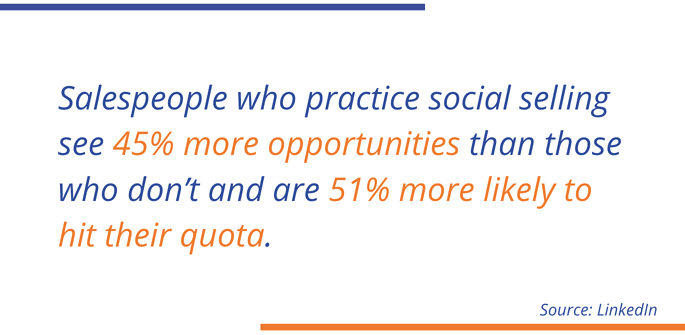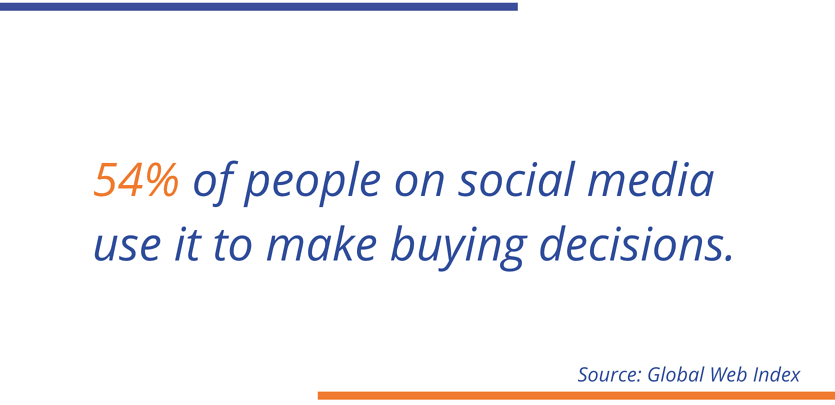Social Selling vs. Social Media Marketing: Which Tactic to Use?
Social media – love it or hate it, your business probably can’t live without it.
Unless you operate in a very specific B2B niche, you need the power and reach platforms such as Facebook, Twitter and Instagram provide to make your business a success. Without them, it can be impossible to reach new audiences and cultivate brand loyalty.
Social media has changed though, and while once simply creating an account and running some ads was enough, the culture and possibilities of these platforms are ever-growing. Social selling, in particular, is a powerful and engaging tactic that plays into the contemporary uses of a platform.
But how does it measure up against traditional social media marketing? In this article, we’ll compare the two and see how you can integrate both into your online strategy.
What’s Social Selling?
Social selling is a method where salespeople can find prospective buyers, connect with them directly on social media, show an understanding of the common challenges of their target audience and offer solutions. This presents the salespeople as credible and knowledgeable about their industry and can result in a prospect to buy.
With social selling, you can turn social media platforms into tools for finding, connecting with, understanding, and nurturing sales prospects for your business. Think of it as developing relationships with potential customers or clients so that when they have a problem you and your products and services can solve, they immediately think of your business.
It’s a more personal, enjoyable, and reasonable way of achieving the same aims as cold calling. However, rather than bombarding strangers with opportunities to improve their business or lifestyle, you’re little by little raising your profile through value-added content. Social selling is a much more casual way to connect and communicate with a potential client.
Today, salespeople who practice social selling see 45% more opportunities than those who don’t and are 51%more likely to hit their quota, according to LinkedIn.

Social selling through platforms such as Facebook, LinkedIn, Twitter, and Instagram show your audience that you’re an active and approachable entity, not just a dormant page. You’ve probably already taken part in social selling without even realizing it. It’s more than building a contact book. It’s about pressing the need to integrate yourself and your business into a prospect’s life.
What’s Social Media Marketing?
Even if you’ve never managed a social media marketing campaign, you’ve been the target of one.
Social media marketing is the effort of extending brand reach and awareness and driving leads through social platforms. Common ways to do this are by sharing different types of content on social media and driving traffic to a website where people can convert to leads.
Social marketing campaigns are created with several different communicative and brand-building goals. Content, videos, images, competitions, audio, and much more are used to build interest in products and services across the most used social media platforms.
According to Global Web Index, 54% of people on social media use it to make buying decisions.

Social media marketing doesn’t necessarily have the goal of revenue generation in the same way social selling does. Instead, it is about establishing a place on those platforms and generating interest through familiarity and world of mouth. Whether free or paid, social media marketing is about driving awareness.
Why You Should Do Both
Social selling and social media marketing should not be seen as separate paths that businesses need to pick between. It’s not an either-or situation. Instead, they should be two arms of one campaign to establish your brand online and build the kind of relationships necessary to thrive in the modern marketplace.
The ideas work in tandem. While working on social selling campaigns that target particular customer bases and other companies, you can also run general marketing campaigns to raise brand awareness and its latest initiatives. As marketing campaigns raise initial awareness of your brand, your sales team adds color and context while building relationships through social selling.
This helps to reinforce the message and encourages a deeper brand relationship with people who haven’t even shopped or worked with you yet.
With both tactics working to the same end, a clever combination of both leads to not just an improved bottom line, but the room for deeper and more expansive campaigns down the line. You can support this integration by anchoring it to a strong marketing communication strategy.
How To Apply Both Strategies
Now, let’s take a look at how to integrate both social selling and social media marketing into your business model.
Here are a couple of things we think are essential for both though.
-
A Great Website With Social Media Integration: Your website needs to impress, and if you’re using social media as an outreach tool, you generally need to have some evidence of expertise in it on your website. Leading templates such as WordPress and Squarespace are a great place to start for new businesses, while cheaper options such as Volusion also have robust social media integration tools.
-
Active Social Profiles: There’s no point approaching brands, thought leaders, or consumers with a proposal or ad if you’re linking them back to a dead page that shows both no social acumen and a lazy approach to advertising. Post interesting content, interact with your audience, and show a willingness to grow on the platform.
Integrating Social Selling
Successful social selling is all about confidence, perseverance, and having the right personalities out there on the front lines fighting for your business.
We recommend using sales experts or people who know your business inside and out for this project. Once you start reaching out to potential customers and clients with social selling techniques, you need to be ready for questions about:
-
The history of the business
-
It’s strengths
-
It’s weaknesses
-
Past successes
-
Unique Selling Proposition
We recommend doing some internal research before making the first contact with a client/customer so you have answers ready for questions about what you can specifically do for their business and industry.
Another approach is to use people from throughout a variety of sectors within your business. Sign up all your leading managers and sales personnel on popular platforms such as LinkedIn and Twitter, and let them get to work building natural relationships with other people in the sector. If you’re seen to have insight and come across as approachable, you’ll start earning wins in no time.
Remember, brands and consumers want to get genuine value from social sale interactions. You can’t take the same attitude as cold calling, people are way too wary of that now. Build relationships and give them something in return for their time.
Integrating Social Media Marketing
First and foremost, good social media marketing requires a strong understanding of which platform is best for your business and its greatest assets.
While it can feel like you have to be on every platform under the sun to get the most out of social media marketing, it’s actually much better to create targeted campaigns on the platforms where your audience is most active and engaged.
For example:
-
LinkedIn — Captures other brands/businesses and career-focused consumers.
-
Instagram — Uses visuals to attract consumers and build brand personality. This is particularly effective for e-commerce.
-
Facebook — Allows you to tap into existing communities and target both organic and paid ads at particular user groups.
-
Twitter — Easier to communicate with editorial staff and journalists to earn exciting PR opportunities.
It’s easy to say both social selling and social media marketing have their own unique benefits for different businesses, but that really is the case. However, they are both worth delving into to test the limits of your brand and experiment with new ways of raising awareness. Have a cautious budget and pick the right personalities and platforms, and you’ll be halfway there.











